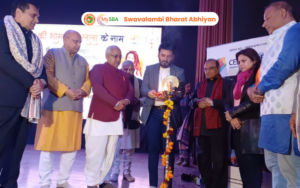Ritual fire to remain lit till consecration ceremony
Apart from the starting of the Yagya, the remaining rituals were also performed on the idol, including “Aushadhadhivas, Kesaradhivas, and Ghritadhivas” Priests involved in the rituals said the fire, which has been lit in the kundas, will be “akhand (continuous)” till the consecration ceremony, and priests will be there to ensure that it continues to remain lit. (Picture credit: Shree Ram Janmabhoomi Trust)
The rituals for the day began early this Friday around 9 am with the lighting of the fire, as part of the “Aranimanthan”, where the fire was lit by rubbing two woods with the help of a cloth.
Apart from the main “yagya shala”, nine kundas (pitchers) of different shapes have been prepared, which were lit on Friday, as part of the “kunda puja” from the fire taken from the “Aranimanthan”.
Apart from the starting of the yagya, the remaining rituals were also performed on the idol, including “Aushadhadhivas, Kesaradhivas, and Ghritadhivas”.
Explaining these rituals, one of the priests performing them said under “Aushadhadhivas”, the idol was covered with water in which 8-10 different types of “aushadhi” (medicines), as written in the “shastras”, were soaked. The idol was then covered with kesar-soaked water and paste made of kesar alone, as part of the “Kesaradhivas” ritual. As part of the “Ghritadhivas”, the idol was soaked in “pure cow ghee” that has come from Jodhpur in Rajasthan.
There was continuous chanting of mantras and the rituals ended with “Dhanadhivas” of the idol in the evening aarti. As part of the Dhanadhivas, about 25-kg of rice was poured on the idol slowly to cover it completely.
Priests involved in the rituals said the fire, which has been lit in the kundas, will be “akhand (continuous)” till the consecration ceremony, and priests will be there to ensure that it continues to remain lit.
Earlier in the day, Shri Ram Janmabhoomi Teerth Kshetra Trust clarified, “Invitation card alone does not guarantee entry into Pran Pratistha Utsav on January 22.”
What is Ram Mandir Pran Pratishtha? What is Ram Lalla? What is the Ayodhya Ram Mandir?0
Ram Mandir Pran Pratishtha refers to the consecration or installation ceremony of the deity Lord Ram in the Ram Mandir. It is a sacred ritual performed to infuse life or divine energy into the idol, making it a symbol of worship for devotees.
What is Ram Lalla?
Ram Lalla is an endearing term used to refer to the infant or child form of Lord Ram. The term "Lalla" in Hindi signifies a young child. In the context of the Ayodhya Ram Mandir, Ram Lalla is a representation of Lord Ram as a child, and it holds great significance in the religious narrative.
What is the Ayodhya Ram Mandir?
The Ayodhya Ram Mandir is a temple dedicated to Lord Ram, located in Ayodhya, Uttar Pradesh, India. It holds immense cultural and religious importance for Hindus and is built at the site believed to be the birthplace of Lord Ram. The temple gained prominence due to a historical and legal dispute, ultimately leading to the construction of the Ram Mandir at the Ram Janmabhoomi site in Ayodhya.
What is the meaning of Yagna Shala?
Yagna Shala is a sacred space or hall specifically designed for conducting Yagnas or rituals in the Hindu tradition. It is a place where various ceremonies, prayers, and offerings are made to deities.
What is the meaning of Yajna Ritual?
Yajna ritual is a Vedic fire ceremony or sacrifice performed to invoke divine blessings. It involves offerings to the sacred fire, chanting of Vedic mantras, and seeking spiritual harmony and prosperity.
What is the meaning of Yagna?
Yagna refers to a ritualistic offering or sacrifice, often involving the ceremonial burning of offerings in a sacred fire. It is a devotional practice aimed at fostering spiritual growth, purification, and divine blessings.
What is the difference between Puja and Yagna?
Puja is a ritualistic worship performed at home or in temples, involving offerings, prayers, and devotional acts. Yagna, on the other hand, is a more elaborate ritual involving fire ceremonies, often conducted for specific Vedic purposes.









